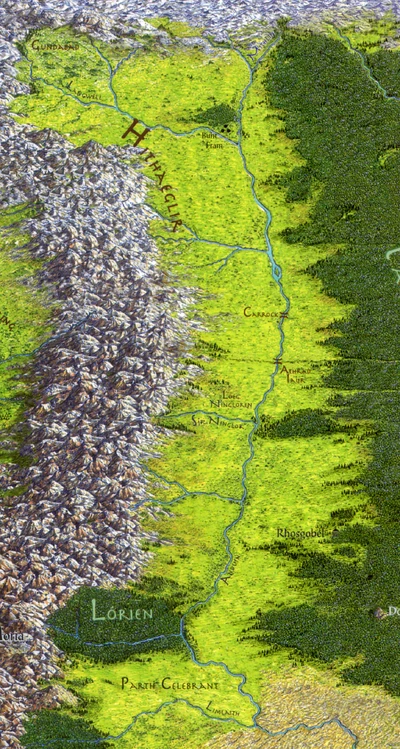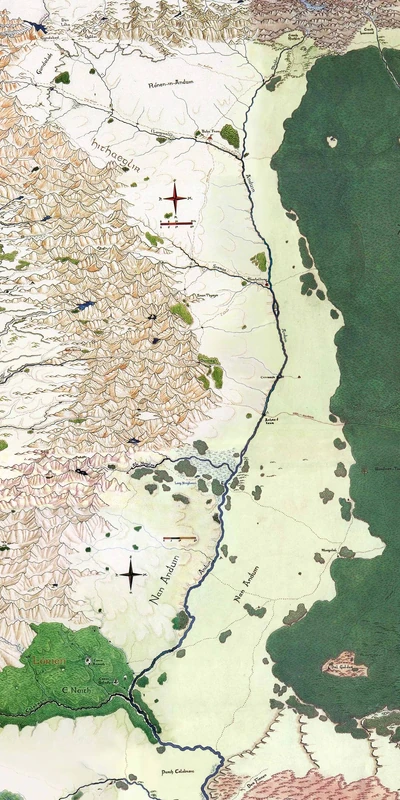
The northern Anduin Vales
Although blessed with the rich soil of the Anduin Valley, the Northmen who had carved their farms out of the wilderness found themselves constantly beset by attack from west, north, and east. To the south lay Gondor, a dubious friend to the independent farmers that seemed content only when the Anduin trade routes poured their bounty into Minas Tirith.
Geographic
- Type: Alluvial Valley.
- Area: 91.100 square miles.
- Elevation: average. 900 feet.
lowest point. Mouth of Celebrant650 feet. highest point. Amon Thyryn(S. "Eagles' Eyrie") 8,002 feet.
- Climate: average annual precipitation: 25-45 inches.
mean annual temperature. 45-55°F average low. Ninui 5°F average high. Urui 90 °F
- Composition: The Anduin cut through lands composed largely
of sedimentary rocks. Conglomerates could be found on the riverbanks. while shale and limestone were more common inland. Little mineralwealth was present in the region, but the proximity of the rich mines of the Misty Mountains more than made up for any natural deficiency the Nan Anduin might have.
- Notes: The Nan Anduin was a fertile swath of land from the
headwaters of the Great River to the Falls of Rauros, where the river slowed and took on a different character. Most people used the term Nan Anduin to refer only to the northern stretches of this region, although it was correctly applied to any of the lands drained by the Anduin. The vales were idle for many centuries until migratory Northmenchoseto settle along the River. Settled valleys lay around Framsburg, Methelburg, and the Carrock, though there were many smaller settlements founded by strong-minded Northman pioneers. Most of these communities were on the right, or western, bank with the most notable exception being the homes of the hardy and strong-willed Beornings. The Anduin valley held some of the richest soil in northwestern Middleearth, but the dangers of Rhovanion prevented the Northmen from exploiting it fully. Rain running off the Hithaeglir provided ample fresh water for the region. Between the settled areas lay numerous swamps and rough lands unsuitable for settlement, the home of many Orcs and bandits. However, the population in the Nan Anduin was low, especially since the Plague, and there is no serious competition for the best lands.
The Realm in T.A. 1640

Nan Anduin
Political Organization: Independent settlements, each ruled by an elite warrior lord. Rulers: Thegn Ansreik of Mathleisbaurg. Herion, Kingsman of Gondor. Berubaur, Waldanabero of the Beiabarnae. Administrative Organization: Each clan strives for self reliance, meeting with the others only for occasional trade and in times of crisis. Within the clan, all power rests with the clan chief, a warrior of noble lineage (frequently the descendant of the previous leader) chosen by all adult males. Population: 7.000 Northmen plus 150 Stoor Hobbits. Military: 100 Beiabarnae. 60 Burgwards of Mathleisbaurg. 900 Militia (3-4 weeks to raise, organized by clan). 135 Eagles (allies). Products: Grain, hides, cattle, honey, amber, tin. Symbol: None
Although blessed with the rich soil of the Anduin Valley, the Northmen who have carved their farms out of the wilderness find themselves constantly beset by attacks from west, north, and cast.To the south lies Gondor, a dubious friend to the independent farmers that seems content only when the Anduin trade routes pour their bounty into Minas Anor. The scattered Northmen and their Hobbit neighbors recognize no common legal system among them, although they stand together in times of need. The Nenedain consider themselves to form over a dozen sub-groups, but Gondorian geographers recognize only two: the bear-cultists who call themselves the Beiabarnae and all of the other Nenedain given the general name of "Northmen." The town of Maethelburg provides the most suitable urban center for trade and council for all residents of the valley. Northman families organize themselves in clan groups, each of which works a plot of arable land hewn out of the wilds. A hereditary thegn rules each clan, and wields power as an absolute patriarch. Even people with no kinship ties join a clan, where they are treated as family. The clan groups range from twenty to sixty people, usually housed inside a stockaded enclosure along with livestock and a sizeable garden. Surrounding the halls are the tilled fields, beyond which are the pastures and wild lands. It is not uncommon for a homestead to be ten or more miles away from the nearest neighbor, for the Northmen are famous as fierce individualists.
The Northmen entered the records ol the West towards the end of the First Age, when they first formed a distinct group. The Elves claim that they are the descendants of a group of the Edain and an indigenous tribe of Middle- earth which called themselves the Mabion Bran. These early Northmen then migrated to the region around the headwaters of the Anduin in the first few centuries of the Second Age.They displaced some tribes of primitive Men, distant relatives of the Drúedain, who migrated south and cast to make way for the tall and fair invaders. The Northmen settled the river banks, each family claiming its own small settlement. The influx of Northman refugees from Eriador after the wars against Sauron in the Second Age did little to alter the established settlement patterns, and the newcomers joined the kin-groups already formed around fortified homesteads. The death of Isildur at the Gladden Fields at the dawn of the Third Age heralded an inevitable period of involvement with the great and rising power of Gondor.The independent Northman farmers were happy to import the luxuries of the South in exchange for their surplus crops, but they soon found royal agents prying into many aspects of their daily lives in order to increase the profits of distant magnates in Gondor. The relationship between the King of Gondor and the Northman clans becomes increasingly strained as the thegns suspect that their wait for Gondorian aid against attacks from Angmar. Mirkwood, and the Misty Mountains grows more futile each day. A Gondorian emissary known as the Kingsman lives in Maethelburg and tries to keep relations as friendly as possible. The Stoor Hobbits of the Anduin Vales are an unassuming society. They have friendly relations with their Nenedain neighbors, but on the whole they prefer to be left alone. They live in their burrows on grassy knolls protruding above the marshes, and few attackers would recognize their village even if they were standing in its midst. The Hobbits trade for any goods they cannot produce themselves through trusted Northman agents, staying out of the towns of the Big Folk unless pressed. They occasionally use boats on the Anduin and through the Gladden Marshes, but rarely do they use the waterways as an avenue for commerce. The grain and furs which const itute the Anduin Valley's primary resources find ready markets in both Maethelburg and Minas Anor, and no small amount of wool and lumber flows south along the river. The Beijabar, who live on the fringes of Mirkwood, provide the wealthy of Gondor with the finest honey and amber in Middle-earth. In return, the Men of Gondor send salt and fine metal objects to the Northmen. Of equal value is the lore which flows North, tor in recent decades, the Northmen have become excellent smiths in their own right. Even a few scholars and poets in Minas Ithil claim the Anduin Valley as their home. Barter is the primary means of exchange, as Gondorian coins remain exceedingly rare. Outright gifts are much more common than purchases made with some form of standard currency. The mercantile ways of the Gondorians remain a mystery to the Northmen, to whom honor and generosity are still valued above the exchange of gold.
References
- merp.com wiki
